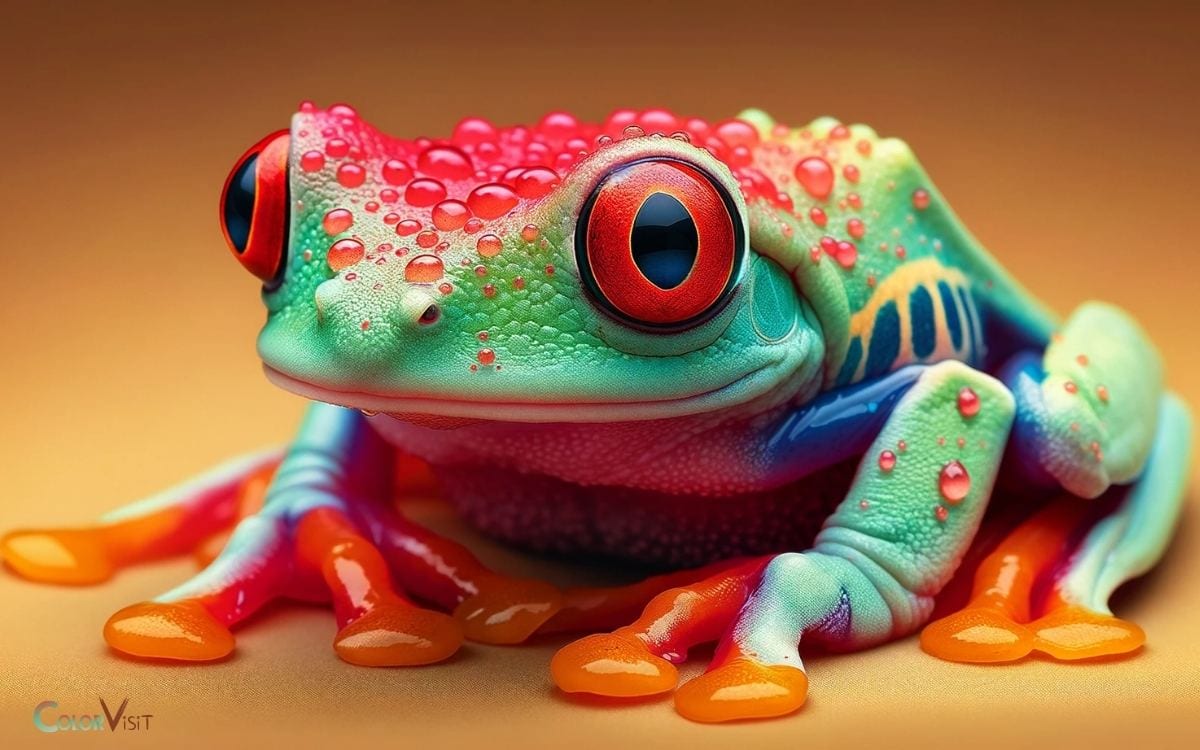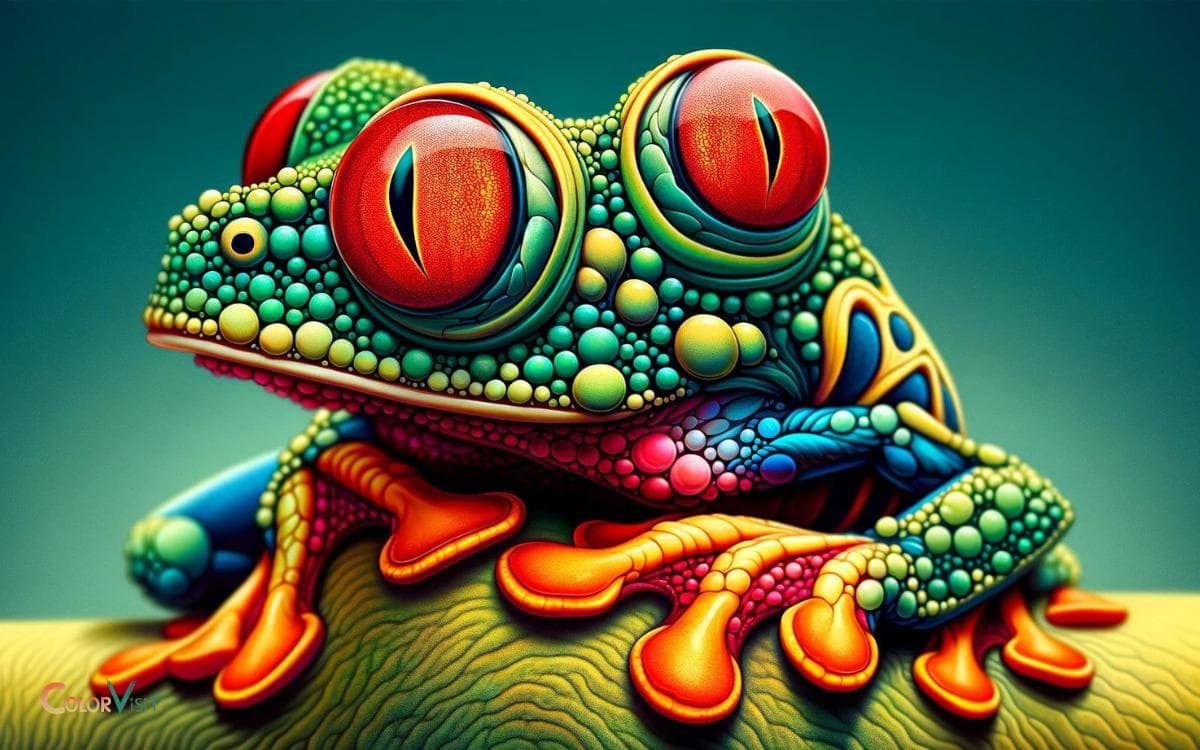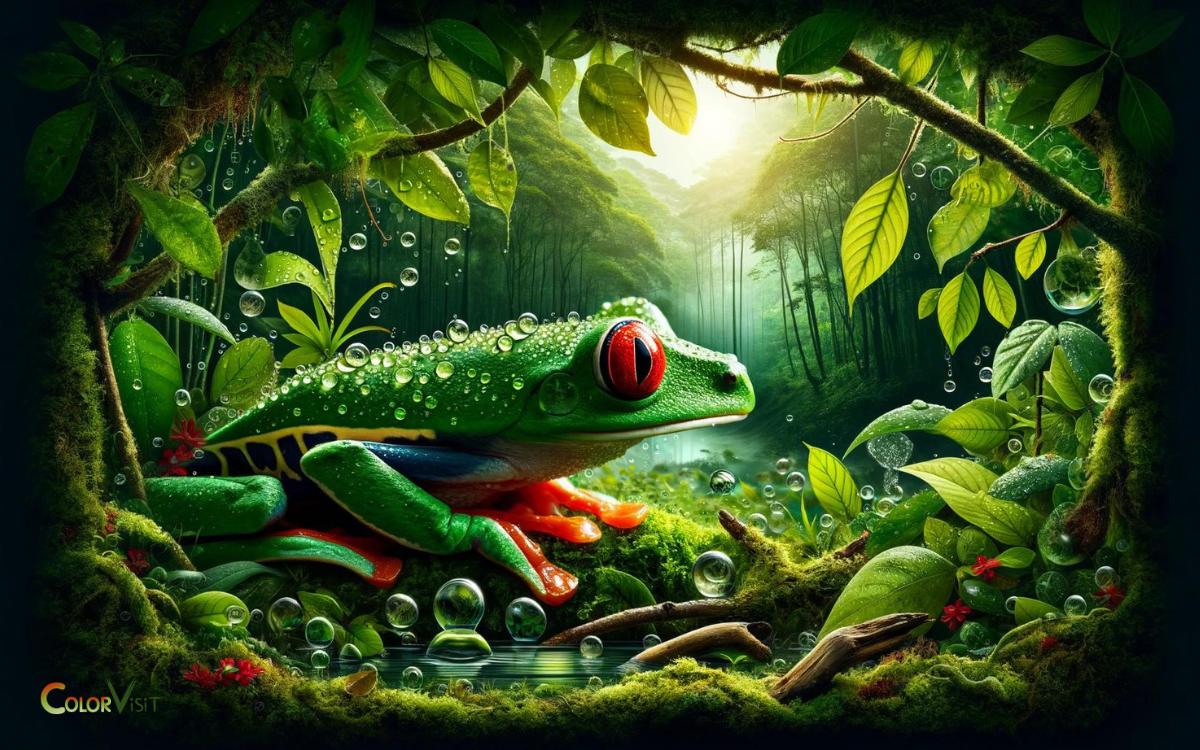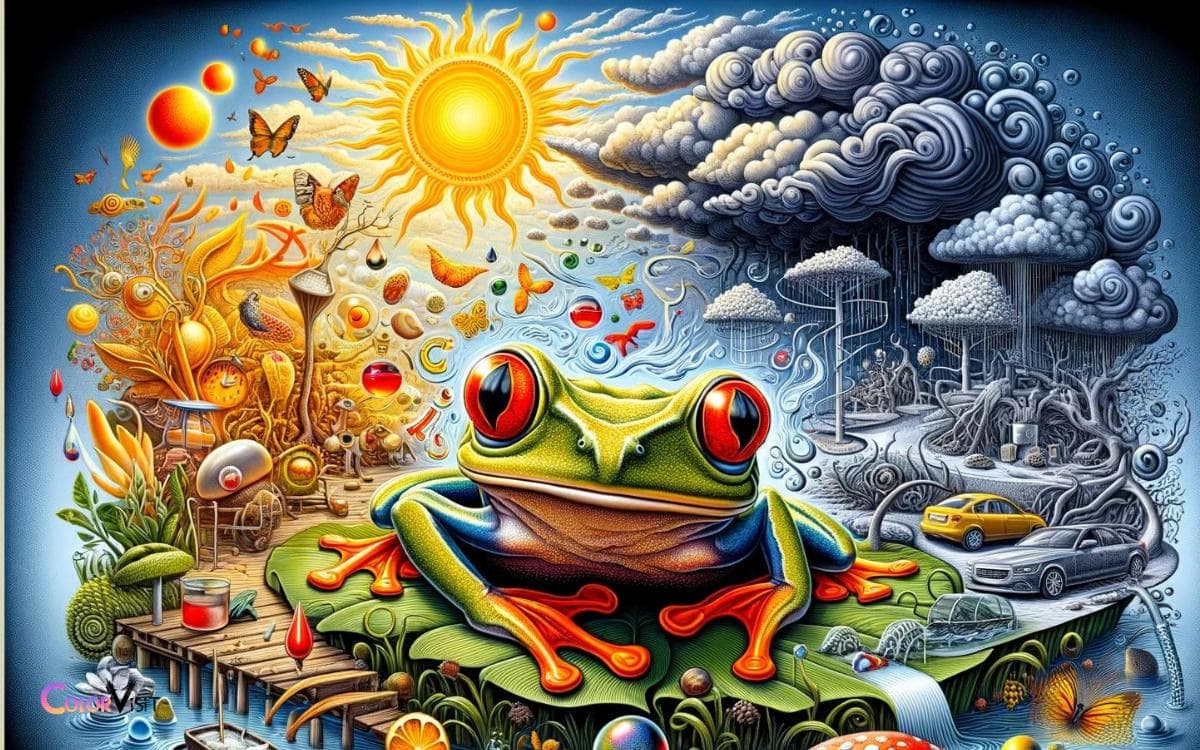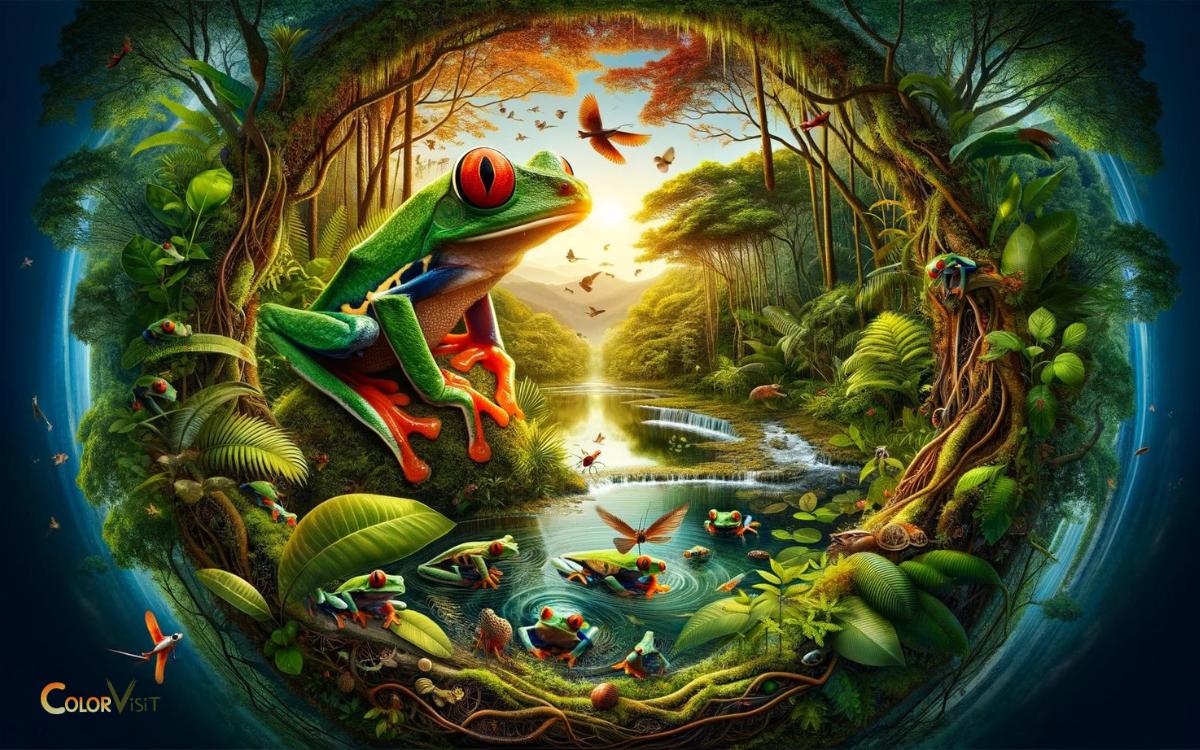Do Red Eyed Tree Frogs Change Color? Yes!
Yes, red-eyed tree frogs possess the ability to change their color based on their mood, temperature, and environment. This feature also aids them in their camouflage.
Red-eyed tree frogs are known to change their color based on their mood, temperature, and environment.
This is a process known as metachrosis, where an animal has the ability to change its skin color.
For instance, during the day when they are inactive and trying to blend into the foliage, they are dark green. However, at night when they are active, they turn a lighter lime green.
This color-changing ability of red-eyed tree frogs is an intriguing adaptation mechanism, offering valuable insights into their survival strategies and behavioral responses.
Key Takeaway
Unique Pigment Cells
While red-eyed tree frogs are known for their vibrant green coloration, the ability to change color is attributed to their unique pigment cells.
- These specialized cells, called chromatophores, contain pigments that can expand or contract, allowing the frogs to alter their coloration in response to environmental stimuli such as light and temperature.
- The chromatophores contain a mix of yellow and blue pigments, which, when combined with the frog’s natural green pigment, create a stunning array of color variations.
- This remarkable ability not only serves as a means of camouflage and thermoregulation but also showcases the incredible adaptability of these amphibians.
Understanding the mechanisms behind the color-changing process in red-eyed tree frogs may inspire innovative solutions in fields such as material science, optics, and adaptive camouflage technology.
Environmental Adaptations
Red-eyed tree frogs have developed remarkable environmental adaptations to survive in their natural habitat.
These adaptations include their ability to change color for camouflage in their surroundings. They also employ temperature regulation techniques to thrive in different climates.
Additionally, their behavioral responses to the environment play a crucial role in their ability to adapt and thrive in various ecological settings.
Camouflage in Surroundings
Adapting to their surroundings, red-eyed tree frogs have developed remarkable camouflage abilities to blend in with their environment.
- Their vibrant green coloration helps them to disappear into the foliage, making them nearly invisible to predators.
- When resting on leaves, they tuck their bright orange feet and expose their green bodies, resembling a leaf’s veins, providing effective camouflage.
- Additionally, their large red eyes serve a dual purpose by intimidating predators and helping them blend in with the red and pink hues of the underside of leaves.
This exceptional ability to conceal themselves allows red-eyed tree frogs to avoid detection, ensuring their survival in the dense rainforest.
Temperature Regulation Techniques
Transitioning from their camouflage abilities, red-eyed tree frogs have also evolved remarkable temperature regulation techniques to adapt to their diverse habitats.
These techniques include:
- Behavioral Adaptations: Red-eyed tree frogs are nocturnal, allowing them to avoid the heat of the day. They also have the ability to change their location within their habitat to find cooler or warmer microclimates as needed.
- Physiological Adaptations: These frogs have specialized skin that aids in temperature regulation. Their skin can reflect sunlight, helping to prevent overheating, or absorb sunlight to increase body temperature when needed.
- Metabolic Adaptations: Red-eyed tree frogs can adjust their metabolic rate to cope with temperature changes, conserving energy during cooler periods and increasing metabolic activity to generate heat in colder environments.
Behavioral Responses to Environment
The behavioral responses of red-eyed tree frogs to their environment demonstrate a high degree of adaptability and environmental acumen.
These frogs have evolved unique behavioral traits to thrive in their diverse habitats. One such adaptation is their ability to change color in response to environmental stimuli.
This behavioral response serves various purposes, including thermoregulation, camouflage, and communication.
The following table illustrates the behavioral responses and environmental adaptations of red-eyed tree frogs:
| Environmental Stimulus | Behavioral Response | Purpose |
|---|---|---|
| Temperature change | Color change | Thermoregulation and camouflage |
| Predators | Rapid movements and vocalizations | Avoidance and warning |
| Rain | Increased activity and mating calls | Breeding opportunities |
These behavioral responses not only showcase the frogs’ ability to adapt to their surroundings but also highlight their innovative strategies for survival.
Camouflage and Predation
Red-eyed tree frogs use their colorful markings and ability to change skin pigmentation to blend into their environment, providing them with an effective form of camouflage against predators.
Their remarkable camouflage and predation tactics include:
- Skin Pigmentation: Red-eyed tree frogs can change the color of their skin to match their surroundings, making them almost invisible to predators.
- Behavior: These frogs are nocturnal and spend their days motionless, relying on their camouflaged appearance to avoid predators.
- Eyespots: The vibrant red eyespots on their sides startle predators, giving the frogs an opportunity to escape while the predator is momentarily surprised.
Behavioral and Physiological Triggers
During various environmental changes, red-eyed tree frogs undergo color changes as a response to behavioral and physiological triggers.
These triggers play a crucial role in the frog’s ability to adapt to its surroundings and protect itself from potential threats.
Behavioral triggers, such as stress or fear, can cause the frog to change color as a means of blending in with its environment or signaling its emotional state to other frogs.
| Behavioral Triggers | Physiological Triggers |
|---|---|
| Stress | Temperature |
| Fear | Humidity |
| Communication | Light levels |
Color Change in Different Life Stages
The color change in red-eyed tree frogs occurs during different life stages, from tadpole to adult frog.
Tadpoles are typically a dull greenish-brown color, while adult frogs display vibrant red, blue, and yellow colors during mating season.
Understanding the specific triggers and reasons behind these color changes is essential to comprehending the frogs’ behavior and survival strategies.
Tadpole to Frog Color
As tadpoles metamorphose into adult frogs, their coloration undergoes a significant transformation.
This change in color serves various purposes, including camouflage, communication, and thermoregulation.
Here’s how the color change occurs:
- Camouflage: Tadpoles often have a dull, mottled appearance that helps them blend into their aquatic surroundings. As they transition into frogs, their coloration becomes more vibrant and may blend with the foliage or other elements in their terrestrial environment.
- Communication: Adult frogs use their colors to communicate with each other, especially during the breeding season. Bright and contrasting colors can signal readiness to mate or serve as a warning to potential predators.
- Thermoregulation: The color change in frogs can also help regulate their body temperature. Darker colors absorb more heat, helping them warm up, while lighter colors reflect sunlight, preventing overheating.
Adult Mating Season Colors
The color transformation from tadpoles to adult frogs continues to play a crucial role in their survival and reproduction.
- Particularly during the mating season, their colors serve as signals for communication and mating readiness.
- Adult red-eyed tree frogs display vibrant greens, blues, and yellows, believed to aid in attracting potential mates.
- This transformation in coloration not only enhances their aesthetic appeal but also signifies their reproductive fitness.
- During the mating season, the intensity of their colors can change, reflecting their hormonal and physiological status.
- This change in color indicates their suitability for mating. Furthermore, these colors may also serve as a warning to potential predators, signaling their toxicity.
Understanding the intricacies of color change in adult red-eyed tree frogs during the mating season is critical. It is essential for developing conservation strategies to protect this species and their habitats.
Conservation Implications
Periodically, understanding the conservation implications of color changes in red-eyed tree frogs is crucial for effective management and protection of the species.
The ability of red-eyed tree frogs to change color in response to environmental conditions has significant conservation implications, including:
- Habitat Monitoring: Monitoring color changes in red-eyed tree frogs can provide valuable insights into the health of their habitat, allowing conservationists to identify and address potential threats such as pollution or deforestation.
- Climate Change Research: Studying how color changes in red-eyed tree frogs correlate with climate patterns can contribute to broader research on the impacts of climate change on amphibian populations.
- Educational Outreach: Highlighting the color-changing ability of red-eyed tree frogs can raise awareness about the importance of preserving their natural habitats and the broader significance of biodiversity conservation.
Conclusion
The ability of red-eyed tree frogs to change color is a remarkable adaptation that allows them to survive and thrive in their environment.
Their unique pigment cells and behavioral triggers enable them to blend in with their surroundings and avoid predation.
This color-changing ability symbolizes the resilience and resourcefulness of these fascinating creatures, reminding us of the beauty and ingenuity of the natural world.
It is a testament to the intricate balance of life and the importance of protecting our diverse and extraordinary wildlife.
